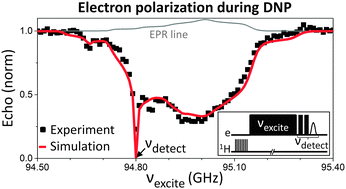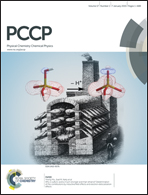The electron depolarization during dynamic nuclear polarization: measurements and simulations†
Abstract
Dynamic nuclear polarization is typically explained either using microscopic systems, such as in the solid effect and cross effect mechanisms, or using the macroscopic formalism of spin temperature which assumes that the state of the electrons can be described using temperature coefficients, giving rise to the thermal mixing mechanism. The distinction between these mechanisms is typically made by measuring the DNP spectrum – i.e. the nuclear enhancement profile as a function of irradiation frequency. In particular, we have previously used the solid effect and cross effect mechanisms to explain temperature dependent DNP spectra. Our past analysis has however neglected the effect of depolarization of the electrons resulting from the microwave (MW) irradiation. In this work we concentrate on this electron depolarization process and perform electron–electron double resonance (ELDOR) experiments on TEMPOL and trityl frozen solutions, using a 3.34 Tesla magnet and at 2.7–30 K, in order to measure the state of the electron polarization during DNP. The experiments indicate that a significant part of the EPR line is affected by the irradiation due to spectral diffusion. Using a theoretical framework based on rate equations for the polarizations of the different electron spin packets and for those of the nuclei we simulated the various ELDOR line-shapes and reproduced the MW frequency and irradiation time dependence. The obtained electron polarization distribution cannot be described using temperature coefficients as required by the classical thermal mixing mechanism, and therefore the DNP mechanism cannot be described by thermal mixing. Instead, the theoretical framework presented here for the analysis of the ELDOR data forms a basis for future interpretation of DNP spectra in combination with EPR measurements.


 Please wait while we load your content...
Please wait while we load your content...